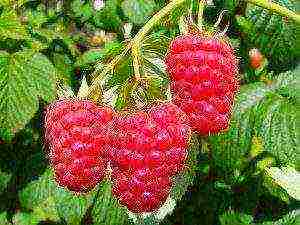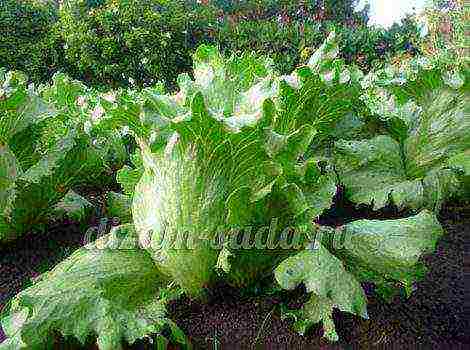Content
.
Cabbage has been known to the population for a long time. For all the time of its existence, breeders have bred not very many varieties. Despite their small number, each summer resident tries to choose the variety that suits him best, but do not forget about the responses of other summer residents. What is the reason for this, what are the prevailing differences between the types, we will consider in this article.
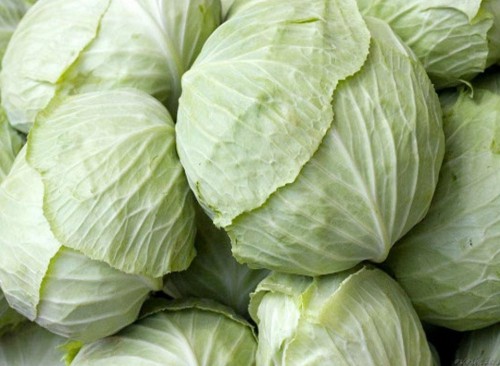
Gribovskiy 147 - early variety of cabbage with small heads
Varieties of varieties
Almost no specialist can distinguish cabbage, especially after cutting. The vegetable culture has no special taste differences. Outwardly, almost all vegetables have the same shape. Varietal variety of white cabbage is mainly due to the different climatic weather conditions prevailing in a particular region. According to climatic conditions, all varieties are divided into:
- cold-resistant;
- heat resistant;
- drought-resistant.
The climate is difficult to predict, especially in the northern regions. Therefore, experts recommend taking varieties that have passed the test in these conditions.
Each variety of white cabbage ripens differently, therefore, according to the time it takes to fully grow the crop, it is classified into:
- early maturing;
- mid-season;
- medium late;
- late.

Variety Polyarny k-206 is suitable for growing in Siberia
Early ripening varieties
In early cabbage, cabbage heads are small, the type is low-yielding, the fruits often crack, so it is not recommended to store them. It takes 90-120 days to ripen a culture from the moment of sowing. The early varieties are used fresh. There are the following varieties of early maturing cabbage:
- № 1 Gribovskiy 147 - round smallish fruits of medium density. If the spring has been long, then most of the culture forms flower stalks. It is unstable to the keel and is greatly affected by it.
- No. 1 Polar k-206 - forks are dense, rounded, need good soil, moisture-loving, frost-resistant. If the type is grown in the North, then the cabbage can be stored and fermented, in other regions it is consumed fresh.
- June - early ripening, medium fruits have excellent taste. Suitable for the climate of the Khabarovsk Territory and the Urals. Cold snaps and frosts down to -5 degrees are not afraid of her.
- Early ripening - amicably growing round forks resemble June forks in terms of ripening and taste.
- Transfer F1 - high-yielding, does not crack during ripening, medium-dense heads of cabbage reach 1.5 kg in weight. Early cabbage needs fertile soils and is hygrophilous.
- Malachite - small, dense fruits, high-yielding variety, early, fruits practically do not crack.
- Parel F1 is a stable high-yielding variety of vegetables, heads of cabbage are resistant to cracking, the culture is not stored for a long time, therefore it is used fresh. Fusarium wilting is not scary to fruits.
- Athlete F1 - small round fruits do not give in to cracking, are used for making soups and salads.
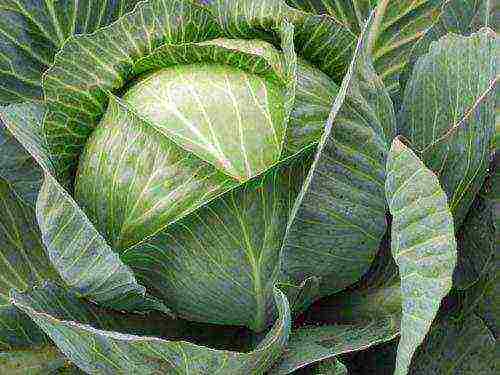
Transfer F1 variety gives high yields if irrigated regularly
Mid-season varieties of culture
The varieties are the most productive. The period of full maturation is 120-150 days. Some species are perfectly stored, used not only fresh, but also suitable for any kind of processing. Let's list the best ones:
- Slava 1305 - medium-dense round culture forks weigh 3-5 kg. The culture has good taste properties. Average storage time, used for fermentation.
- Belorusskaya 455 - fruits of a round or flat shape, medium-yielding. Keeps perfectly fresh and fermented. Susceptible to bacterial decay.
- Sibiryachka 60 is a high-yielding universal crop. Dense round fruits have excellent taste.
- Hope - a non-cracking appearance has flat-round heads of cabbage. Stored on average up to 4 months. Recommended for fermentation and salads.
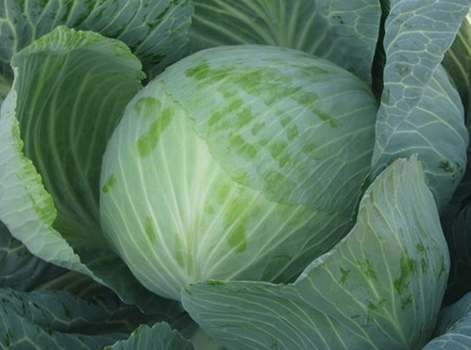
Belarusian cabbage 455 is great for pickling
Mid late view
The ripening period of a medium late variety is 130-160 days. The fruits are well stored, and the sauerkraut is excellent in taste. There are such mid-late varieties:
- Gift 2500 - a fruitful variety of white cabbage, resistant to various diseases and attacks of pests, has a good taste. Cotes are dense, flat-rounded, weighing 3-3.5 kg.
- Far Eastern is a versatile type, keeps well and tastes good. Dense heads of cabbage with a rounded flat shape. Able to carry any type of transportation.
- Blizzard is a medium-yielding crop with dense, round fruits. Little prone to cracking, good storage, suitable for fermentation.

Cabbage Gift 2500 gives large heads of cabbage, practically unaffected by diseases
Late varieties
The growing season for this variety of cabbage exceeds 150 days. These are the best types of white-headed vegetables, which are perfectly stored during the long Russian winters. Among the late varieties are:
- Moskovskaya late 15 is the best high-yielding type of cabbage for pickling, but this variety is not suitable for storage. The forks weigh up to 6 kg. The culture needs fertile soil, does not like waterlogging.
- Amager 611 - there is no better variety for long-term storage in winter. Fruits with a bitter taste, rough, not suitable for fermentation. The taste of the fruit changes for the better during storage.
- Wintering 1474 - flat-round dense fruits reach 4 kg in weight, they are perfectly stored in the winter. The palatability becomes significantly better after several months of storage.
- Creumont F1 - the qualities of the hybrid are very close to those of the Dutch. Fruits are dense, stored for up to six months, do not lend themselves to fusarium wilt, have a good taste.
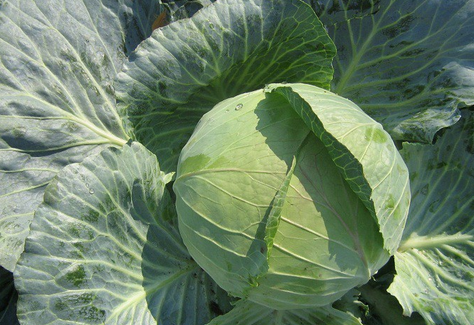
Cabbage Zimovka 1474 improves in taste with prolonged storage
Dutch hybrid varieties
White cabbage hybrids from Holland are known to everyone. In Russia, Dutch breeding is highly valued, where they managed to breed hybrids that can be stored for up to 9 months, are less susceptible to various diseases, and practically do not crack.
Russian scientists quite often test imported types of cabbage. The following hybrids turned out to be the best and most resistant to cold climatic conditions:
- Krautkayser F1 is an excellent salad variety with dense round forks. Good for fermentation.
- Bartolo F1 is the most famous hybrid in Russia. The head of cabbage is slightly elongated elliptical in shape, weighs up to 3 kg, the fruits are dense. Stored all winter.
- Rinda F1 - fruits are round, dense, up to 6 kg, do not crack. Belongs to mid-season, has an excellent taste, is suitable for use in any form, is perfectly stored.
- Portula F1 - the forks are dense, grow up to 6 kg, the hybrid is well stored, suitable for winter processing and for salads.
- Donar F1 is a kind of hybrid for long-term storage, it can be stored for more than 8 months without losing its taste. Medium late white cabbage has firm, medium-sized forks. Suitable for use in any form.
Today the market for plant seeds is quite extensive. Various domestic and foreign types of white cabbage are presented on the shelves. It is not surprising to get lost in all this diversity.
I want to try everything. But still, when choosing, you should listen to the advice of experienced gardeners, so that later it does not turn out that the variety is not at all suitable for the climatic conditions of your region.
Among the foreign varieties, there are also good ones that are suitable for our latitudes, but it is better to choose domestic species that are zoned in the conditions of our strip.
Subscribe Be aware of new products on our site
White cabbage is an incredibly healthy vegetable with a rich vitamin and mineral composition. This explains its popularity among gardeners. The cultivation rules are not complicated, but the basis for the yield depends on the choice of the variety.
Varietal variety of white cabbage
In the old days, there was really a shortage of seed material due to limited supplies from the near and far abroad, therefore, the seeds were often harvested from the usual varieties.
For more than 20 years, the situation has changed radically, and the varietal assortment of many gardeners continues to consist of 2-3 positions. And in vain, because new developments have no less valuable qualities, which consist in resistance of cabbage to diseases and pests.
This is especially important when you consider that the moisture-loving plant literally attracts insects and fungi.
This article discusses early, mid-season and late-ripening varieties of a popular vegetable with a description that will expand the variety of crops grown in your garden and in the Urals and in the middle lane.
Most Popular
The variety of cabbage is selected not only taking into account the winter and climatic characteristics of the region, but also by appointment... The mineral and vitamin composition of each plant is different, but it is also influenced by the conditions of agricultural technology and the type of soil.
In order to choose the appropriate option it was easier, the varietal assortment is divided into groups, united by a common feature.
The best late varieties of cabbage for long-term storage
Aggressor Is a mid-late hybrid developed by breeders from Holland. Differs in minimal care and resistance to fusarium, thrips damage.
Vegetation lasts up to 120 days, you can sow seeds directly on an open bed. A ripe vegetable weighs 3-5 kg. Shelf life and processing - up to 5 months.
 Aggressor
Aggressor
Amager - late cabbage with a ripening period 120-147 days... The heads are round-flat green, sometimes with a bluish tinge, weight about 3-4 kg.
When planting, the scheme is used: 3-4 plants per 1 m2. For six months, the nutritional value and presentation are preserved. Weather cataclysms and violation of the watering regime do not violate the density of the structure and the integrity of the head.
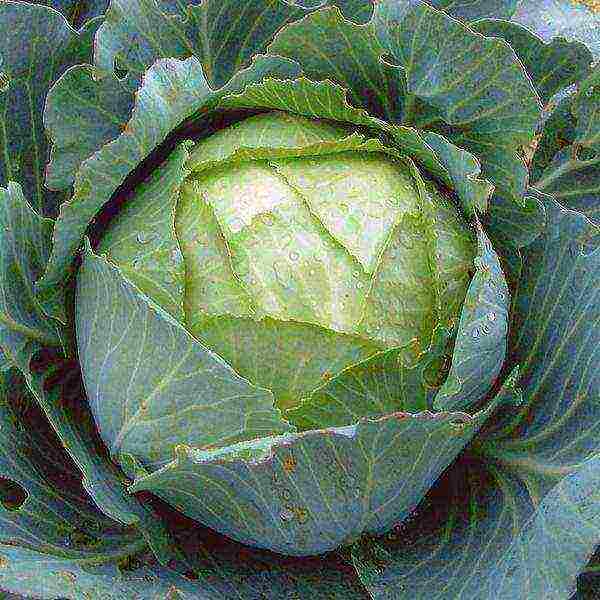 Amager
Amager
Valentine - growing season 155-180 days after transferring seedlings to open beds. The gray-green heads have a slight waxy coating, the weight tightens up to 4 kg.
Cabbage retains its taste and presentation until the beginning of the next season (June). The hybrid is tolerant to fusarium, gray rot. The head of cabbage does not crack due to violations of the moisture regime.
When planting, the scheme is used: 2-4 plants per 1 m2.
 Valentine
Valentine
Gingerbread man - hybrid forms heads later 115-125 days after planting seedlings. Round fruits have a dense structure, the average weight is 2-3 kg. Planting scheme: 3-4 plants per 1 m2.
Due to its good immunity, it exhibits tolerance to punctate necrosis and thrips. For 8-10 months, cabbage retains its nutritional value and presentation.
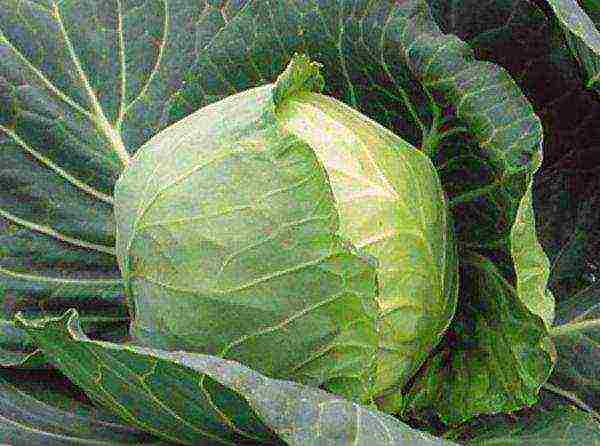 Gingerbread man
Gingerbread man
Mara - very dense heads are not susceptible to cracking, the average weight is 3 kg. The variety is distinguished by good taste, transportability and long shelf life (more than 7 months).
The main advantage is resistance to the accumulation of nitrates and radionuclides. Vegetables are harvested through 160-175 days after transplanting seedlings.
 Mara
Mara
Moscow - a variety developed by domestic breeders, who took into account the climatic features and possible problems with pests when growing.
Harvesting begins later 130-140 days after disembarking seedlings. Gray-green rounded heads of cabbage weigh 4-7 kg on average.When planting, the scheme is used: 2-3 plants per 1 m2.
Cabbage is resistant to cracking, has a delicate juicy pulp. Without loss of taste and presentation, the vegetable is stored for 6-8 months.
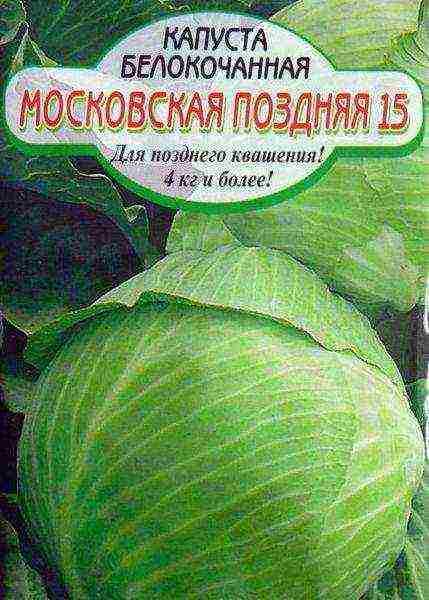 Moscow
Moscow
Mid-season white cabbage
Megaton - the hybrid matures in 102 days after planting seedlings. The great need for moisture and fertilizers strengthens the immune system, which resists many diseases and insect infestations.
The round-flattened gray-green head weighs up to 15 kg. The location of the holes when planting: 3 plants per 1 m2. Duration of storage without loss of nutritional qualities and presentable appearance is 4-6 months.
Merchant's wife - a disease-resistant high-yielding variety, distinguished by simple agricultural technology. About 500 centners are removed from a hectare (head weight up to 3 kg). When planting, the scheme is used: 3-4 plants per 1 m2.
Harvesting begins later 130-150 days after transferring seedlings to the beds.
 Merchant's wife
Merchant's wife
Atria - the fruit of the works of Dutch breeders with the growing season 110-120 days... The head of cabbage has a round-flat head of blue-green color, the average weight of which reaches 5-7 kg. Often there are specimens of 8-8.5 kg. When planting, the scheme is used: 3 plants per 1 m2.
Thanks to its good immunity, it resists pests (in particular thrips) and fusarium. The commercial and taste qualities are preserved for 4-6 months.
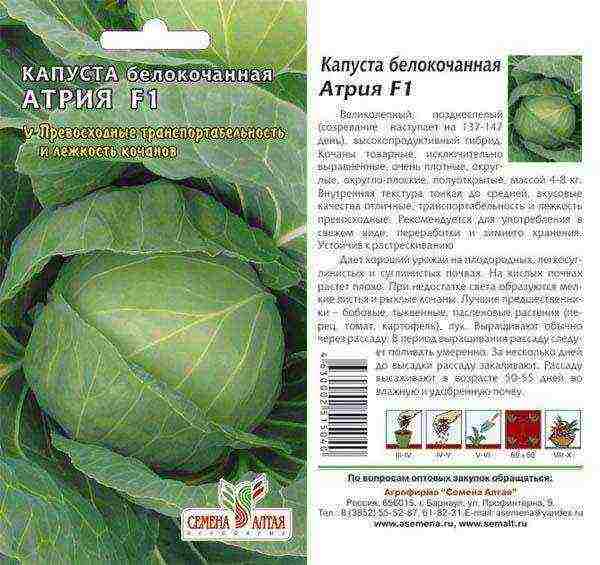 Atria
Atria
Glory - the fruit of the work of Russian breeders, the growing season is 120-130 day after planting seedlings.
Round heads have a light green color with a grayish tinge, the weight tightens up to 3-5 kg. When planting, the holes are arranged according to the scheme: 3-4 plants per 1 m2.
The advantage of the variety is its taste, the disadvantage is short storage (about 2 months). Glory is one of the best pickling options.
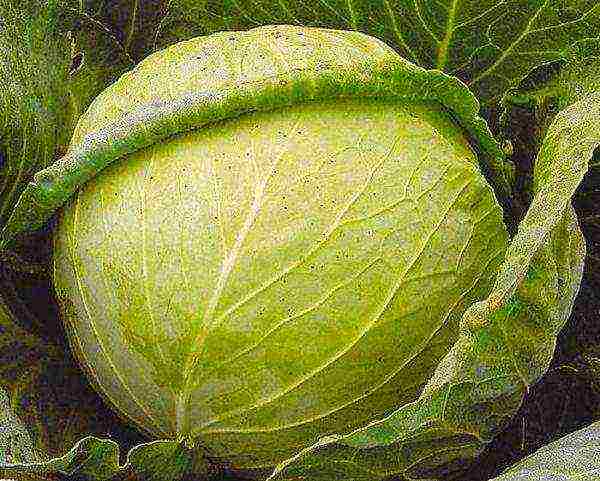 Glory
Glory
Sugar queen - the hybrid ripens after planting seedlings through 120-140 days... Dense rounded heads have a slightly greenish tint, weighing up to 4 kg.
When planting, the scheme is used: 3 plants per 1 m2. A universal variety, used fresh and for salting. The shelf life without loss of valuable qualities is 3-4 months.
 Sugar queen
Sugar queen
Early ripe
Rinda - the ripening period of the hybrid is 75-80 days after disembarking seedlings. Round heads weighing up to 7 kg have a green color and a dense structure. Hole layout: plant 3-5 plants per 1 m2. Differs in unpretentiousness to weather conditions.
The shelf life without loss of taste and presentation does not exceed 4 months.
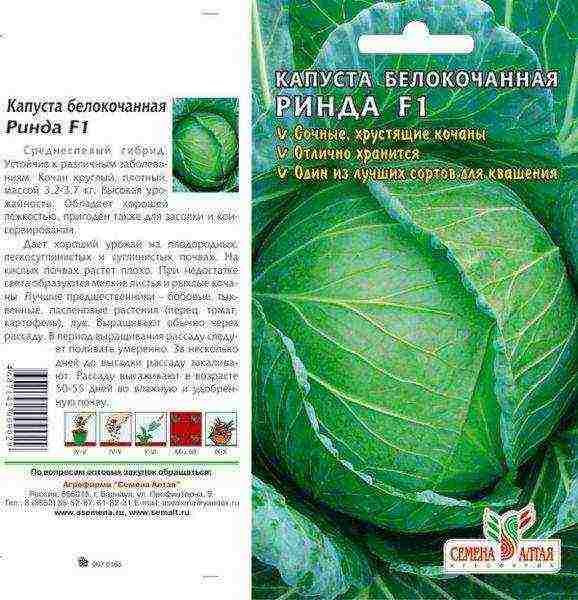 Rinda
Rinda
Kazachok - an early hybrid is distinguished by early maturity, you can harvest through 45-55 days after disembarking seedlings. The weight of the medium-sized light green head is 1.5 kg.
The scheme used for planting: 5-6 plants per 1 m2. Recommended for cultivation under any kind of film and in the open field. Cabbage resists the causative agents of mucous bacteriosis and black leg.
 Kazachok
Kazachok
June - the variety is ready for planting in open ground already at the beginning of May, after 45-50 days you can harvest. The structure of the head is of medium density, the weight reaches 1.4-1.7 kg. When grown on highly fertile soils, the weight of a head of cabbage reaches 5 kg.
The layout of the holes when planting: 3-5 plants per 1 m2. Cabbage is distinguished by the amicability of the emergence of seedlings and excellent taste.
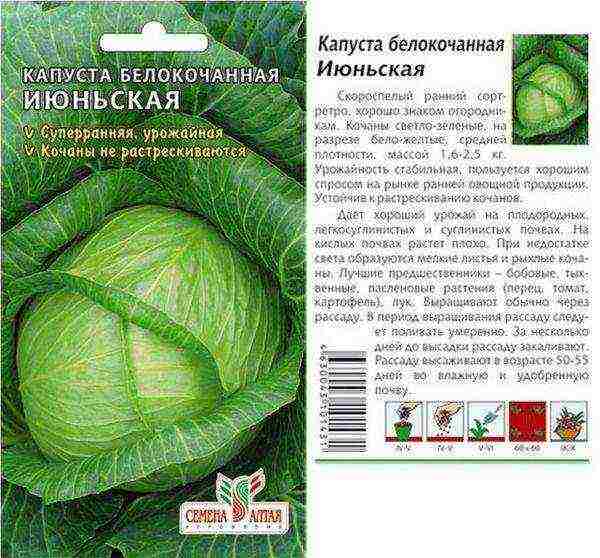 June
June
Tobia Is a Dutch hybrid characterized by resistance to fusarium wilt. The layout of the holes when planting: 2-3 plants per 1 m2. Round-flat heads of dark green color reach a weight of up to 7 kg. Fruit ripening occurs later 85-90 days after disembarking seedlings.
It has a strong root system, if the irrigation regime is violated, the head of cabbage does not crack. It retains its taste and marketability for 5-6 months.
 Tobia
Tobia
Varietal variety will ensure yields even in difficult weather conditions, because each plant has its own immunity to diseases and pests.The taste qualities of the varieties stimulate new experiments, which continue already in the kitchen.
Many summer residents and gardeners especially appreciate the quality properties of white cabbage. Therefore, this type of vegetable crop is one of the most often grown in beds and gardens.
As historians note, white cabbage was first planted in the 4th century BC. Over a long period, it has changed, although up to 2 years A.D. there were about 5 varieties. Basically, new varieties of white cabbage appeared only at the beginning of the twentieth century. It was then that active selection work began.
Today, the best varieties of white cabbage can be distinguished according to various indicators and properties.
Before choosing the required type of large-headed vegetable, you need to clearly define what it is for. It should be noted that early, medium and late varieties of white cabbage are intended for different consumer purposes.
For example, early cabbage does not store for a long time, has a very good and delicate taste, and has resistance to shooting. It is intended for fresh summer consumption, or for preparing other dishes. The best variety for this is the Golden Hectare. The varieties that ripen later can be stored longer, are also resistant to high summer temperatures, and have an average shelf life.
Late varieties should be planned for long-term storage. They develop slowly. The growing season passes without much care (you only need to fertilize and water on time). They are resistant to cold weather and pests. Late varieties of white cabbage are also intended for pickling. They are often grown by entrepreneurs for sale during the winter part of the year.
What varieties of white cabbage (see photo with the name) should you choose to get a good harvest and meet your needs?
The best varieties of white cabbage:
- Malachite. It is the earliest variety of white cabbage. Has small heads. The weight of one of them does not exceed two kilograms. Very juicy and spreading cabbage. The structure is moderately dense. The head of cabbage is hard. Grows well in temperate and warm climates. Loves frequent watering. Growing fast. If planted in a greenhouse, the growing season can be reduced to 5 days.
- Taurus F1. A popular early variety of white cabbage. Summer residents are very fond of growing it in their garden, since the fruits in a short period of time and subject to all the rules and principles of cultivation, reaches a weight of about 6 kg. Among the advantageous properties, it should be noted resistance to many diseases and pests. The growing season lasts up to 100 days. The Taurus F1 cabbage variety can be grown in temperate climates.
- Dobrovolskaya. One of the most productive, juicy and sweet varieties. The weight of one head can reach a record 8 kg. On average, fruits are harvested weighing 5 kg. Belongs to the category of mid-season varieties of white cabbage. Mid-season cabbage is used for food and is intended for the preparation of many dishes. It is grown for sale by agricultural enterprises. Many varieties have good keeping properties. The uniqueness of the variety is that it is endowed with natural properties of protection against many diseases and pests. Thanks to this, the summer resident can count on high yields. The shelf life of Dobrovolskaya cabbage is almost six months (up to 5 months).
- Present. The vegetable is very tasty, juicy and nutritious, has a spicy zest. It is easy to recognize among other varieties, since the surface of the green leaves has a slight waxy coating. The weight of one fruit does not exceed 4 kg. The advantage of the Podarok variety is that it lends itself well to transportation without losing its shape. It is widely used for pickling and fermentation for the winter. Many are positioned as the best variety of medium-ripening white cabbage.
- Krautman F1. A hybrid variety, which has a dense structure of the fruit, weighing up to 5 kg., Has a small stump.Heads of cabbage do not crack even under abrupt changes in weather conditions. Delicious, pleasant vegetable is great for complex salting, preservation and fermentation. It is one of the kilo-resistant varieties of white cabbage.
- Geneva. Excellent late-ripening variety, ripening period - up to 140 days. One of the earliest among the late varieties. It has many advantages (good keeping quality, is not damaged during growth, has a dense structure, is transportable). Can be stored until a new harvest.
- Moscow late. Description of the Moscow late white cabbage variety will allow every summer resident to understand why it is one of the best. It is only necessary to announce the parameters of its heads of cabbage - they can reach a weight of 8-10 kg. The rosette at the head is large and rather spreading. The fruit has a rounded flat shape. It is resistant to many diseases, especially keel. A relatively frost-resistant variety that can withstand temperatures as low as 50C. Stores well until the next harvest. Heads of cabbage are dense, therefore they are easy to transport. This is the best late variety of white cabbage.
 White cabbage varieties are divided into several types:
White cabbage varieties are divided into several types:- Early maturing, with a short growing season (65-115 days from germination to technical ripeness). These varieties are distinguished by medium-sized, medium-density heads of cabbage, delicate, thin leaves. They are used fresh and for the preparation of various dishes. Not suitable for fermentation and storage.
- Mid-season (115-150 days). During the summer period, cabbage of these varieties forms normal heads of cabbage, surpasses the early varieties in yield. Mid-season varieties differ in purpose - there are varieties for fermentation, there are varieties for long-term storage.
- Late ripening (150 days or more). In late varieties, heads of cabbage are denser than in mid-season or early ones. Used for long-term storage and fermentation.
The success of the harvest depends a lot on the right varieties. There are a large number of varieties and hybrids created for different climatic zones. Here are the varieties adapted for widespread cultivation.
Early varieties
June... Early (90-110 days from germination to technical ripeness) variety. Heads of cabbage with a diameter of 14-20 cm, weighing 0.9-2.4 kg., Round, medium density, good taste.
Zarya MC... Early (107-118 days from germination) variety. The head of cabbage is round, weighing 1.6-2 kg., Medium density, does not crack.
Dumas F1... Early ripening (110 days from germination) hybrid. The head of cabbage is round, weighing 0.8-1.5 kg. Medium crack resistance, suitable for thickening planting.
Early ripening... Early (94-103 days from germination) variety. The head of cabbage is round, 11-19 cm in diameter, weighing 0.9-2 kg, dense. Prone to cracking, affected by keel, weakly affected by spring fly.
Transfer F1.Early (96-118 days from germination) hybrid. Heads of cabbage with a diameter of 15-17 cm, weighing 0.8-1.5 kg., Round, medium density, good taste. The variety is resistant to pathogens of vascular bacteriosis, strongly affected by fusarium, wilting and keel.
Malachite F1... Early (92-137 days from germination) hybrid. The head of cabbage is round, 16-17 cm in diameter, weighing 1.3-1.5 kg, medium density, good taste. The variety is affected by the keel, moderately resistant to vascular bacteriosis.
Cossack F1... Early (106-112 days from germination) hybrid. The head of cabbage is round, with a diameter of 15.5-17.5 cm, weighing 0.8-1.2 kg, dense, of excellent taste. The variety is resistant to mucous bacteriosis and black leg, moderately resistant to keel. Resistant to cracking.
Number one Gribovsky 147... Early (102-117 days from germination) variety. Heads of cabbage are round, 16-23 cm in diameter, weighing 0.9-1.9 kg, medium density, good taste. It is prone to damage by vascular bacteriosis, it is strongly affected by the keel.
Dot... Early (98-123 days from germination) variety. Heads of cabbage are conical, 17 cm in diameter, 0.7-1.7 kg in weight, medium density, loose.
Mid-season varieties of white cabbage
Glory 1305... Mid-season (105-130 days from germination) variety. The head of cabbage is round and round-flat, weighing 4-5 kg., Dense, resistant to cracking. The variety is susceptible to keel, vascular bacteriosis, fusarium wilt.For fresh consumption, pickling, heads of cabbage are stored until January.
Hope... Mid-season (120-135 days from germination) variety. The head of cabbage is round or round-flat, weighing 2.4-4.5 kg., Good density, does not crack. It is intended for fresh consumption and for fermentation.
Belarusian 455... Mid-season (105-130 days from germination) variety. Heads of cabbage are round-flat, weighing 1.3-4.4 kg., Dense, do not crack. Suitable for fermentation. Stored until December-January.
SB-3 F1... Mid-season (130-135 days from germination) hybrid. The head of cabbage is round, weighing 3.0-4.5 kg., Dense, excellent taste. High-yielding. The variety is resistant to causative agents of the main diseases of cabbage. For fresh consumption and fermentation.
Krautman F1... Mid-season (123-135 days from germination) hybrid. Heads of cabbage weighing 3-4 kg., Dense, Resistant to cracking. High-yielding.
Rinda F1... Mid-season (123-140 days from germination) hybrid. Heads of cabbage are round, weighing 3.2-3.7 kg. (up to 8 kg.), dense, excellent taste. Resistant to major diseases of cabbage, to cracking. For fresh consumption and for processing.
Menza F1... Mid-season (125-140 days from germination) hybrid. Heads of cabbage are round-flat, weighing 4-9 kg, dense, of excellent taste. The variety is resistant to adverse weather conditions. It is intended for fresh consumption, fermentation, long-term (until March) storage.
Midor F1... Mid-season (125-140 days from germination) hybrid. The head of cabbage is round and flat-round, weighing 2.3-4 kg., Medium-dense, excellent taste. It is intended for fresh consumption, fermentation and long-term storage.
Tobia F1... Mid-season (125-140 days from germination) hybrid. A head of cabbage weighing 4-8 kg., Dense, excellent taste. It is intended for fresh consumption, processing and storage (up to 6 months).
Late-ripening varieties of white cabbage
Amager 611... Late (145-167 days from germination) grade. Heads of cabbage are round-flat, weighing 2.4-6.1 kg., Dense. The palatability improves during storage. The variety is not resistant to pathogens of vascular bacteriosis, moderately resistant to keel. For long-term storage.
Gingerbread man F1... Late (144-150 days from germination) hybrid. Heads of cabbage weighing 4.2 kg., Round, dense, excellent taste. It is affected by keel and cabbage fly. Medium resistant to white rot pathogens. For fresh use, fermentation and long-term storage.
Creumont F1... Late (165-170 days from germination) hybrid. Heads of cabbage are round or flat-round, weighing 1.9-2.1 kg., Dense, good taste. The variety is resistant to vascular and mucous bacteriosis, to cracking. For long-term storage.
Extra F1... Late ripening (155-160 days from germination) hybrid. Heads of cabbage are round-flat, weighing 2.5-2.8 kg, good taste, dense, do not crack. The variety is resistant to a complex of diseases. For fresh consumption, fermentation and long-term storage.
Smooth F1... Late (146-163 days from germination) hybrid. Heads of cabbage weighing 1.8-2.3 kg., Round, dense, good taste. Stable yield. Moderately susceptible to keel. For long-term storage.
Moscow late 15... Late (145-160 days from germination) grade. Heads of cabbage are round or flat-round, medium density, weighing 3.3-4.5 kg., Excellent taste. The yield is high. The variety is susceptible to fusarium wilt and downy mildew. Suitable for fermentation.
Sugar Loaf... Late ripening (130-160 days from germination) variety. Heads of cabbage are round, weighing 3-4 kg., Dense, sweet, juicy. The variety is suitable for fermentation and long-term storage (until May-June).
Megaton F1... Medium late (142 days from germination) hybrid. The head of cabbage is round, dense, weighing up to 10 kg., Excellent taste. Resistant to fusarium, moderately resistant to keel and gray rot.
Present... Late (145-165 days from germination) grade. Heads of cabbage are round, weighing 2.0-3.6 kg., Dense, good taste. High yield, excellent storage. The variety is susceptible to fusarium wilting, mucous and vascular bacteriosis, keel.
Wintering 1474... Late ripening (165-175 days from germination) variety. The head of cabbage is flat-rounded, weighing 3.6 kg. The palatability improves during storage.For long-term (up to 8 months) storage.

